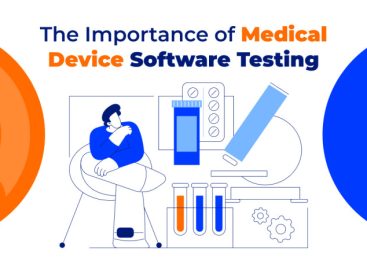- QATestLab Blog >
- QA for Business >
- Cases >
- From Troubled Launch to Excellence: A Startup’s Real-Life Success Story
From Troubled Launch to Excellence: A Startup’s Real-Life Success Story

Startups pulsate with energy, innovation, and the drive to change the world with their software. Yet, even the most promising ideas can stumble if quality falls short. In the dynamic world of startups, where speed and agility are essential, QA often gets overlooked, leading to costly mistakes and missed opportunities.
In this article, our goal is to discuss why QA matters – and matters intensely – for software development startups. We will delve into the most common quality pitfalls startups face, putting your ambitious project at risk. Then, we will turn to an in-depth case study, showcasing the power of efficient, tailored QA services in a real startup scenario.
By the end, you will gain a clear understanding of how expert QA can contribute to your startup’s success. Discover the measurable benefits, learn from others’ experiences, and protect your software investment from the roadblocks that could derail your vision.
Startup QA: Key Issues to Prevent
According to CB Insights, one of the most significant reasons for startup failure is running out of funding. This highlights two crucial aspects: resourcefulness and product impact. Both come into play when impressing investors with a viable and in-demand product that deserves continued funding.
Effective testing proves essential in releasing solutions that gain user traction and shine within their market niche. As a reliable QA provider with years of experience in supporting startups on their path to achieving and maintaining software excellence, we are eager to share insights and tips on building testing processes that fit the needs of these companies. Let’s start with the key challenges faced on this journey:
1. Tunnel Vision
A holistic understanding of the software is vital for the entire development team. This includes technical features, user needs, and potential user expectations. The broader the knowledge base shared among developers, designers, and testers, the higher the quality outcome. For instance, if your QA team is tasked with UX or exploratory testing, having a clear picture of user goals and interactions with your software will allow them to identify more issues and offer valuable recommendations.
2. Neglecting the Little Things
With limited resources and a product that just starts gaining momentum, focusing on major features and fixing critical bugs is often a startup’s primary focus. However, not paying attention to small defects, which can be quickly improved, may be a dangerous path. Especially when users point out to them in their reviews or in feedback as they uninstall the app or unsubscribe from a service.
3. The Missing Metrics
Software testing metrics serve as essential tools for measuring progress, quality, and productivity of QA activities. With these metrics in hand, testers can effectively plan their work and seamlessly integrate QA processes into the ongoing development workflow. Although there is no one-size-fits-all approach. Selecting relevant metrics depends on the specific goals established for each QA procedure.
For instance, if your testing objective is building confidence in your software, focusing on Result metrics like user-discovered bugs or product failure rates becomes crucial. On the other hand, if the primary goal is detecting as many defects as possible, Process metrics come into play. In this case, you will have to pay close attention to the total number of bugs discovered, as well as their severity and priority distribution. Regardless of your objectives, choosing the relevant testing metrics allows you to obtain valuable data on the current state of your product, pinpointing problematic areas and indicating release readiness.
4. Emulators: A Double-Edged Sword
While undeniably being a cost-effective solution, testing solely on emulators does not offer the complete picture. In some scenarios, employing virtual devices is perfectly acceptable. For example, for early product testing phases, including unit testing, emulators and simulators can be valuable tools.
However, certain types of testing require checking your software in real-world environments. Verification on physical devices equips QA teams with crucial insights into usability and accessibility, minimizing the risk of crashes and critical defects on devices commonly used by your target audience.
5. Developer-Driven Testing
Some startups entrust their development teams with the full scope of QA responsibilities, aiming to conserve resources and accelerate releases. Yet this approach carries significant drawbacks.
When tasked with full-fledged testing duties, developers have less time to focus on their core tasks: developing new features or modifying existing ones. Juggling between detecting and fixing bugs can compromise the final product’s quality.
In contrast, a dedicated QA team works in collaboration with developers, providing prompt feedback after every update. Additionally, testers bring a fresh perspective, uncovering overlooked and unexpected issues.
By understanding and overcoming these challenges, startups can establish robust testing processes that pave the way for high-quality software, user satisfaction, and ultimately, success in the competitive landscape.
Case Study: From Startup Nightmare to Success Story
In this case study, we will focus on the journey of our client – a startup developing a financial app aimed at giving efficient recommendations for people interested in small-cap US stocks. These recommendations leverage a comprehensive analysis of various financial indicators, insights from analytical agencies, and in-depth information analysis from the software itself.
Client’s challenges:
- The startup launched their MVP with major quality issues due to poor initial selection of the software development vendor and lack of testing.
- New development vendor created an app from scratch, but post-release issues like crashes and notification failures persisted.
- After the initial public release, the app presented various compatibility issues, on most Android devices and old models of iPhones, in particular.
- Since the app worked on a subscription-based model, the startup faced the risk of tremendous financial and reputational loss.
Client’s needs:
- The company required the assistance of an experienced QA team with a deep understanding of their development workflow, unbiased perspective and the ability to test the software from the end user’s point of view.
- To improve and maintain the quality of the app, the client needed help with designing an efficient test strategy and incorporating well-planned testing activities into the development process.
- The client wanted to ensure a smooth and reliable experience for their users across various devices. This involved addressing compatibility issues and ensuring the app functioned as intended for the target audience.
- The team also needed to streamline their development process by implementing automated testing. Their main goals were to save time and resources, which would allow them to focus on core development and marketing activities.
Our solution:
After spending hours upon hours of trying to find a feasible solution to improve the quality of their financial app and boost the efficiency of their testing efforts, the startup’s CTO decided to leave a request for a free consultation on our website.

The next day we signed an NDA with our client and launched our collaboration. Later on, the startup’s Development Team Lead let us know that the biggest advantages they focused on while choosing their QA vendor were our flexibility in terms of selecting QA engineers with various skills and experience, the fast start of testing we ensured by joining the client’s team after 36 hours with all the necessary resources, and, of course, our vast pool of real testing devices for pinpointing the app’s compatibility problems.
To ensure comprehensive test coverage and smooth incorporation of new QA activities, QATestLab provided our client with the following services:
QA Integration: Our Integration Manager identified the root cause of issues through interviews with stakeholders across the whole client’s team.
Test Management: A dedicated QA Project Manager guided the team through the testing process, designed a detailed and transparent test strategy taking into account all of the client’s business needs, and offered valuable insights as to the organization of efficient testing.
Independent Testing Team: We selected a team of independent testers with relevant qualification for every type of QA tasks. They provided the client’s development team with unbiased feedback and advocated for the user’s perspective, fostering healthy collaboration between the QA engineers and developers.
Automated Testing: Implementation of automated testing for key functionalities of the app improved product stability and reduced manual testing efforts. This allowed our client to save time and budget on testing the product after the further updates.
Team Management: Our QA engineers joined the client’s team with their own equipment, including the necessary set of real gadgets to verify the software across different OSs and hardware configurations. In addition, our client didn’t have to worry about the long hiring process or providing sick leaves and vacations, as all these aspects are handled on our side.

QA Results:
- Improved product quality
Comprehensive testing significantly reduced bugs, ensured smooth app functionality across various devices and got the software ready for a successful release.
- Enhanced user experience
By addressing compatibility and functional issues, the app delivered a reliable experience for users, regaining their trust and confidence of the investors.
- Streamlined development process
Automated testing saved time and resources, allowing the client’s team to focus on their core responsibilities and the development of new functionality.
- Increased user satisfaction
Improved app performance led to positive user feedback, which now significantly outnumbers the amount of negative reviews on app stores, and boosted the expansion of our client’s customer base.
Key Takeaways and Best QA Practices for Startups
Based on this success story, our team would like to highlight the following practical tips to ensure that your startup begins its journey of a high note:
1. Don’t delay the integration of testing into your development process
Involving experienced testers at the early stages of product development helps build a strong codebase and flexible software architecture, ensuring high quality and saving resources on maintaining the product in the future.
2. Leverage independent testing expertise
Independent testers provide unbiased feedback, identify user-centric issues, and promote healthy collaboration between the QA and development specialists.
3. Consider the benefits of a testing vendor
Hiring a testing vendor offers access to experienced professionals, a wider resource pool, and potentially lower overall costs compared to in-house recruitment and equipment sourcing.
4. Focus on real-device testing
Thorough testing on real devices that reflects user base demographics helps to ensure a seamless experience across various environments.
5. Embrace test automation
Implementing automated testing helps maintain consistent quality throughout the development process and reduces manual testing efforts and QA costs in the long-run.
Launching a successful startup requires a focus on quality from day one. Hope this article helps you impress the market with your innovative software, secure substantial funding, and gain much trust and support from your users.
As an experienced QA provider, we understand that flexibility and adaptability are vital for startups when it comes to choosing the right service vendor. This is why we made sure that our testing services can be customized to accommodate different business needs, budgets, and timelines. Tell us a bit about your product, and let’s discuss how efficient QA can help you build an excellent reputation for your startup.
Learn more from QATestLab
Related Posts:
- How to Achieve a Balanced QA Approach in a Startup?
- Testing of MVP: What Is the Benefit for Startups?
- VivaTech 2025: Wearable AI, Next-Gen Robotics, and Assistive Accessibility Devices
About Article Author
view more articles







No Comments Yet!
You can be the one to start a conversation.